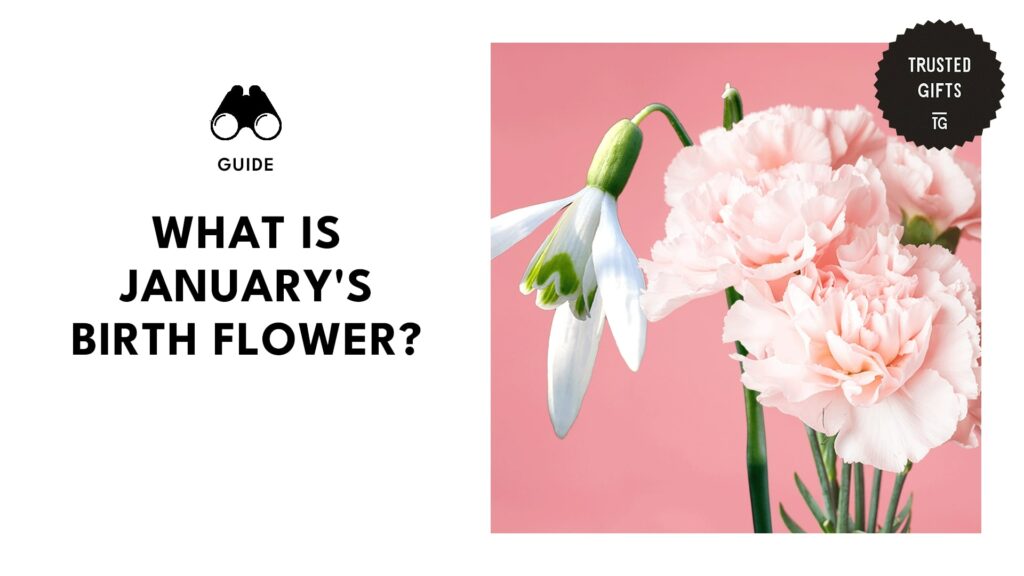As January unfurls its frost-kissed beauty, it brings forth a duo of enchanting blooms to grace the birthdays of the month. These flowers carry a touch of winter’s magic and have their own charm.
In this article, we will discuss everything you need to know about January’s birth flowers, their symbolism, varieties, and cultural significance.
What are the January birth flowers?


The two official birth flowers for January are carnations and snowdrops.
Carnations symbolize love, fascination, and devotion, while snowdrops represent renewal, hope, and rebirth.
Carnation


Carnations have delicate ruffled petals and a fragrance that captures the essence of romance. There’s no doubt why they are the official first wedding anniversary flowers.
They come in different colors and varieties which makes them a great choice for sending heartfelt messages on special occasions.
The Meanings of Carnations
White


White carnations symbolize innocence, purity, wealth, good luck, new beginnings, and success.
These blooms are a timeless choice for those celebrating new significant moments in their lives, whether it be a graduation or an engagement.
Pink


Pink carnations symbolize remembrance and gratitude, which makes them an ideal choice for expressing thanks on occasions like Mother’s Day.
Red


Red flowers may be widely recognized as symbols of love, but red carnations can actually be given to anyone close to your heart.
Dark-red carnations radiate vibrant passion and convey deep love and romance. Lighter shades represent gentle affection or friendship.
Purple


Breaking away from the regal associations of typical purple flowers, purple carnations symbolize capriciousness.
These are the perfect gifts for the unpredictable people in your life to show that you understand and appreciate their spontaneous nature.
Blue


Blue carnations symbolize spirituality, peace, and truth just like other blue flowers.
They are frequently chosen for weddings as they also symbolize devotion and true love, and embody the commitment and harmony between the couple.
Yellow


Unlike the usual meaning of yellow flowers, yellow carnations symbolize disappointment, sadness, and rejection. Gifting them is a gentle way to express apologies and sympathy.
Orange


Orange carnations burst with warmth, desire, fascination, and enthusiasm. These blooms are perfect for expressing admiration or showing your interest in someone special.
Varieties of Carnation
Dianthus caryophyllus


Dianthus caryophyllus is the most common species of carnations, and it blooms in summer.
It has a sweet clove-like fragrance and star-shaped flowers in different shades like red, yellow, white, or pink.
This flower has slender bluish to grayish-green leaves and can mature up to 4 feet in height.
Dianthus chinensis


This variety of carnation is a low-maintenance plant that typically blooms from spring to fall.
It adds a burst of color to gardens with its serrated petal corolla in red, magenta, white, or bicolor and grass-like leaves.
It thrives in various climates and can reach heights of up to 2.5 feet.
Dianthus carthusianorum


The Dianthus carthusianorum features star-shaped flowers with frilled petals in pink, magenta, or white.
They usually grow in dry grasslands or mountain slopes and bloom in summer. They can grow up to 2 to 3 feet and have clumps of narrow, strap-like leaves.
Dianthus barbatus


Dianthus barbatus is a captivating carnation variety that features vibrant colors such as purple, white, pink, or red, often with margins in different shades.
This flower is native to mountainous regions of Asia and Europe and has clusters of up to 30 individual flowers per stem with a spicy aroma.
Dianthus plumarius


Dianthus plumarius is a carnation variety that is native to Germany, Slovenia, Croatia, Italy, and the United Kingdom.
They bloom from spring until summer and have open, flattened pink corolla flowers.
They have frilled-edged petals and dark red rings in the center and can grow up to 2 feet.
Historical and Cultural Significance of Carnation


Snowdrop


The snowdrop, scientifically known as Galanthus, is a harbinger of winter’s retreat and got its name from its resemblance to snow. It enchants with its dainty, pendulous blossoms that delicately rise through the frost-covered earth.
The Meanings of Snowdrops


As one of the first flowers to grace the thawing landscapes, the snowdrop flower symbolizes hope, fertility, renewal, and rebirth. It also serves as an encouragement to overcome life’s challenges.
Its pristine white petals signify purity, innocence, and spirituality. The snowdrop is also believed to express love, care, and appreciation, which makes it a thoughtful gift in the cold months.
In times of sorrow, the snowdrop also becomes a symbol of condolence or sympathy.
Varieties of Snowdrop
Galanthus ‘Atkinsii’


This snowdrop variety has white, plump tepals and a unique inverted green heart-shaped mark on the inner petals.
It can reach heights of up to 25cm, which is very impressive compared to other varieties.
The has long and slender outer white petals with leaves that are often folded back.
Galanthus nivalis


Galanthus nivalis, also known as the common snowdrop, stands out with its resilience and simplicity.
It can reach heights of up to 12 cm–15 cm and is well-suited for planting under deciduous trees.
It has drooping flowers that feature inner tepals with green markings at the tip.
Galanthus elwesii


Commonly named the greater snowdrop, this variety boasts a height of 25 cm–30 cm, which makes it larger compared to other varieties.
It has flowers with green markings resembling an inverted ‘U’ at the tips and bases of the petals and the leaves will turn yellow as they age.
Galanthus elwesii ‘Polar Bear’


The ‘Polar Bear’ is one of those rare varieties of snowdrops. It has upward-facing flowers and wide-open outer tepals.
The upward-directed flowers resemble tiny propellers, and the inner tepals have a deep shade of green.
While most snowdrops bloom in winter, this variety blooms in spring.
Galanthus nivalis f. pleniflorus ‘Flore Pleno’


The ‘Flore Peno’ is a sought-after double-flowered variety of snowdrop because of its inner tepals that look like frilly skirts. “Double-flowered” means it has multiple layers of petals.
These tepals give the flower a unique and enchanting appearance with streaky smudges of green and occasional yellow or orange markings.
Historical and Cultural Significance of Snowdrop






